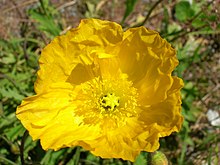Papaver alpinum
| Papaver alpinum | |
|---|---|

| |
| Scientific classification | |
| Kingdom: | Plantae |
| Clade: | Tracheophytes |
| Clade: | Angiosperms |
| Clade: | Eudicots |
| Order: | Ranunculales |
| Family: | Papaveraceae |
| Genus: | Papaver |
| Species: | P. alpinum
|
| Binomial name | |
| Papaver alpinum | |
| Synonyms[1] | |
| |
Papaver alpinum, synonym Oreomecon alpina,[1] the Alpine poppy or dwarf poppy, is a poppy found in the Alps. The circumscription of the species varies considerably. In some treatments, the species is one of a group of related species, and includes several subspecies, four of which are found in Austria. In other treatments, it includes species that have been treated as separate, and has at most one subspecies.[2]
Description
[edit]The Alpine poppy is a short, upright, hairy perennial with odd-pinnate leaves. The flower grows to a height of 5 to 20 cm, with several upright and hairy stems. As with all poppy species, a latex is produced. The feathery leaves are arranged in a ground hugging rosette.
The flowers are hermaphroditic and radially symmetric, with a diameter of up to 5 cm. The fragrant flowers do not have nectar, but produce pollen. The flowering period is from July to August.
All Alpine poppy subspecies have a strong taproot and make a good rockery plant. The root hairs are angled upwards, which helps secure the plant.
Subspecies
[edit]This section needs additional citations for verification. (June 2023) |

The Rhaetian Alps poppy (P. alpinum subsp. rhaeticum) has light yellow to orange petals and feathery foliage, and is found in the Central and Southern Alps. In Austria, it is scattered around Carinthia, Styria and Salzburg; in Switzerland, it has only been found in the Engadin.
The Salzburg Alpine poppy (P. alpinum subsp. sendtneri) also has pinnate deciduous leaves, with white flowers with a yellow heart. It grows only in the northern Alps and Northern Limestone Alps. It is found in moving limestone rubble, boulders, lime rock or dolomite. It prefers a high altitude of 1300 to 2600m. Although the protected plant is rare, it is the most commonly found white flowering Alpine poppy. In Austria it is found in Tyrol, Vorarlberg, Upper Austria, Salzburg and Styria.
The Kerner-Alpine poppy (P. alpinum subsp. kerneri), or Karawanken Alpine poppy, has two to three times pinnate deciduous leaves and bright yellow flowers. It is found in the southeastern Limestone Alps, with a main distribution in the Slovenian Alps. In Austria it is only found in the southern Carinthia.
The Northeast Alpine poppy (P. alpinum subsp. alpinum, also known as P. burseri Crantz), or the Burser-Alpine poppy, has two to three times pinnate deciduous leaves with white flowers and is found in the northeastern Limestone Alps. In Austria it is found in Lower Austria, Upper Austria and Styria.
Other subspecies:
- P. alpinum subsp. ernesti-mayeri, with white flowers
- P. alpinum subsp. dubium, with bright red flowers
- P. alpinum subsp. corona-sancti-stephani (Zapal.)
- P. alpinum subsp. degenii (Urum. & Jáv.), found in Bulgaria and considered a full species by some authors [3][4]
Chemistry
[edit]The alkaloids amurensine and amurensinine can be found in P. alpinum.[5]
References
[edit]- ^ a b "Oreomecon alpina (L.) Banfi, Bartolucci, J.-M.Tison & Galasso". Plants of the World Online. Royal Botanic Gardens, Kew. Retrieved 2023-06-07.
- ^ Schönswetter, Peter; Solstad, Heidi; Escobar García, Pedro & Elven, Reidar (2009), "A combined Molecular and Morphological Approach to the Taxonomically Intricate European Mountain Plant Papaver alpinum s.l. (Papaveraceae) — Taxa or Informal Phylogeographical Groups?", Taxon, 58 (4): 1326–1343, doi:10.1002/tax.584020, JSTOR 27757020
- ^ Paghat's Garden: Alpine Poppies
- ^ Natural Resources Canada
- ^ The isopavine structure of amurensine and amurensinine. F. Šantavý, M. Maturová and L. Hruban, Chem. Commun. (London), 1966, pages 36-36, doi:10.1039/C19660000036
Sources
[edit]- Xaver Finkenzeller:Alpine flowers, Munich 2003, ISBN 3-576-11482-3
- Fischer, MA, Adler, W. & K. Oswald:Excursion flora for Austria, Liechtenstein and South Tyrol,Linz, 2005, ISBN 3-85474-140-5
- Bittkau C, Kadereit JW. 2002. Phylogenetic and geographical relationships in Papaver alpinum L. (Papaveraceae) based on RAPD data. Botanische Jahrbücher für Systematik, Pflanzengeschichte und Pflanzengeographie 123: 463–479.
